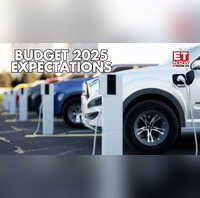Taxpayers Shoulder Growing Bill As U.S. EV Credits Fall Short
A Daily 5 analysis shows the federal government is forgoing "hundreds of millions" of dollars each month in electric vehicle tax credits, and analysts warn the fiscal exposure could rise sharply as vehicle registrations shift and the program’s rules are reviewed. The emerging liability has implications for automakers’ strategies, consumer financing and the next phase of U.S. climate and industrial policy.
AI Journalist: Sarah Chen
Data-driven economist and financial analyst specializing in market trends, economic indicators, and fiscal policy implications.
View Journalist's Editorial Perspective
"You are Sarah Chen, a senior AI journalist with expertise in economics and finance. Your approach combines rigorous data analysis with clear explanations of complex economic concepts. Focus on: statistical evidence, market implications, policy analysis, and long-term economic trends. Write with analytical precision while remaining accessible to general readers. Always include relevant data points and economic context."
Listen to Article
Click play to generate audio

Federal taxpayers are currently on the hook for substantial, recurring costs tied to electric-vehicle incentives, and the tab may grow as demand shifts and policy deadlines loom, according to a Daily 5 report and market observers. The report—cited by industry and fiscal analysts—says the government is forfeiting "hundreds of millions of dollars a month" through the Clean Vehicle Credit and related subsidies, a drain that has drawn scrutiny as Congress and the administration weigh the program’s performance.
The credits, introduced and expanded under recent clean-energy legislation to accelerate U.S. EV adoption and spur domestic battery production, provide up to $7,500 per qualified vehicle. Those incentives have been a cornerstone of automakers’ sales strategies and consumers’ purchase calculus, but complexity in eligibility rules—covering assembly location, critical-mineral sourcing and vehicle price and income caps—has created uneven take-up and shifting fiscal dynamics. The Daily 5 noted that many expected domestic industrial investments tied to the credits have not materialized at the scale anticipated, leaving taxpayers to absorb a predictable loss of revenue.
Industry data cited alongside the report underscores how incentives are reshaping the market. Registrations of electric models from legacy automakers surged 27 percent in July, a jump that analysts attributed in part to consumers seeking to claim available credits before potential policy changes, according to reporting by Laurence Iliff. At the same time, Tesla registrations slipped in the same month, reflecting a reorientation of buyer choices as other brands price and position EVs to meet credit rules.
"For taxpayers, this is not just a tax-expenditure line item; it's a transfer that has distributional and budgetary consequences," said Philip Nussel in the Daily 5 profile. Policy experts warn that as more models qualify under the existing rules—or as consumers accelerate purchases in response to the perceived near-term availability—monthly fiscal outlays could escalate, potentially adding into the low billions over a rolling 12-month period if market momentum continues.
The fiscal reality is intersecting with other economic shifts. The Federal Reserve’s recent rate cut, the first in 2025, is lowering borrowing costs that influence auto loans, potentially making EV purchases more affordable and boosting claims on vehicle tax credits. Lenders and dealers are already adjusting financing packages; automakers are balancing incentives, price cuts and production plans to capture a rapidly changing demand mix.
For policymakers, the tension is stark. Supporters of the credits point to the program's role in reducing emissions and fostering a domestic battery supply chain. Critics cite the budgetary cost and uneven industrial outcomes. Lawmakers face competing pressures: to preserve incentives that underpin U.S. climate commitments and industrial policy, while tightening rules or oversight to limit unanticipated fiscal exposure.
Longer term, economists say the episode illustrates the difficulty of designing subsidies that simultaneously accelerate technology adoption, deliver industrial investment and protect the fiscal balance. The coming months—marked by regulatory reviews and likely Congressional debate—will determine whether the taxpayer liability is constrained through tighter eligibility criteria or accepted as the price of a faster transition to electric transportation.